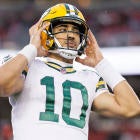Back in May the NFL writers and editors at CBSSports.com gathered together to discuss the key figures and moments of every NFL franchise in the Super Bowl era. Before long we were discussing every team's best and worst moments, along with their most-hated players and coaches, as well as some of the more bizarre things each team has been involved in. That spirited discussion produced this series -- the Good, Bad, Ugly and, sometimes, Bizarre moments for every team. We continue with the Dallas Cowboys.

The Good
The Herschel Walker trade
In 1989, a wildcatter by the name of Jerry Jones bought the Dallas Cowboys for $140 million. In his first move, Jones installed his former Arkansas Razorback teammate Jimmy Johnson -- then the coach at the University of Miami -- as his head coach.
Johnson and Jones struck gold with their first draft pick, a quarterback by the name of Troy Aikman. They also hit big on their third (Darryl Johnston), fourth (Mark Stepnoski), and sixth picks (Tony Tolbert) of the 1989 draft. But it was a move they made five games into that 1989 season that would define their partnership, and lead to the Cowboys dominating the NFL in the early 1990s.
On Oct. 12, 1989, with the Cowboys sitting at 0-5, Johnson sent running back Herschel Walker to the Minnesota Vikings in what would go down as arguably the most one-sided trade in NFL history. Walker was the Cowboys' best player at the time, and one of the best running backs in football. He'd run for 1,514 yards during the 1988 season, second in the league to only Eric Dickerson. He also had 53 catches for 505 yards and finished the year just 17 yards from scrimmage behind co-league leaders Dickerson and Roger Craig. He was 27 years old and, given that this was before people truly understood just how early running backs begin to break down, looked like he had at least a few years of high-level play left ahead of him.
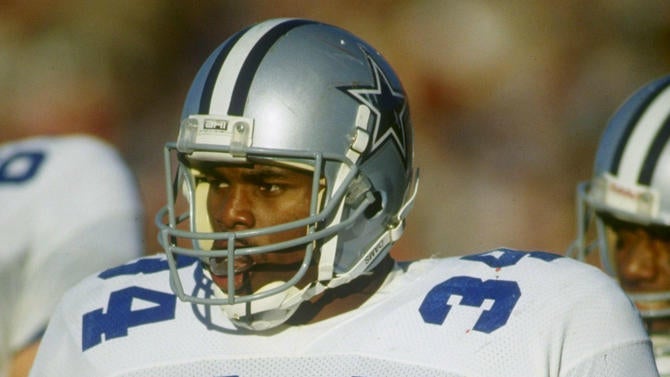
The Cowboys announced that they'd trade Walker, and they received offers from multiple teams. One of those offers was from the Cleveland Browns. The Cowboys, Johnson said at the time, would have received "a player, a couple of future No. 1 draft picks and three No. 2 draft picks."
Feeling that he could get a better offer if he created a bidding war, Johnson called up Vikings GM Mike Lynn and told Lynn that he was going to trade Walker to the Browns that afternoon unless the Vikings could top Cleveland's offer. He gave Lynn a 6:30 p.m. deadline to come up with a package of players, draft picks, conditional picks, and provisions.
And so Johnson got the Vikings, who were 3-2 at the time of the deal and had Super Bowl aspirations, to give up five players and eight draft picks in exchange for Walker and four later picks. The final deal:
Vikings receive:
- Herschel Walker
- 1990 third-round pick (DAL)
- 1990 fifth-round pick (SD)
- 1990 10th-round pick (DAL)
- 1991 third-round pick (DAL)
Cowboys receive:
- Jesse Solomon, David Howard, Isaac Holt, Darrin Nelson, and Alex Stewart
- 1990 first-round pick (MIN)
- 1990 second-round pick (MIN)
- 1990 sixth-round pick (MIN)
- Conditional 1991 first-round pick (MIN)
- Conditional 1991 second-round pick (MIN)
- Conditional 1992 second-round pick (MIN)
- Conditional 1992 third-round pick (MIN)
- Conditional 1993 first-round pick (MIN)
Even on the surface, that trade is a steal. Five players, three firsts, three seconds, a third and a sixth, for Walker, two thirds, and fifth and a 10th. But it's what Dallas did with those picks that made it into the best trade any team has ever made.
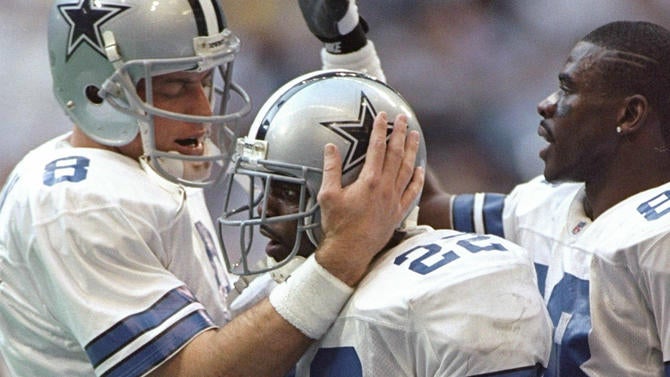
The Cowboys packaged that 1990 first-round pick with another later pick to move up four spots and select Florida running back Emmitt Smith at No. 17, completing the trio of high-level players that would come to be known as The Triplets. Smith went on to become a far better player than Walker ever was, leading the NFL in rushing four times and touchdowns three times, and he's still the NFL's all-time leader in rushing yards and rushing touchdowns. He was an eight-time Pro Bowler and four-time First-Team All-Pro. He helped lead the Cowboys to three Super Bowl victories and in one of them was named Super Bowl MVP.
Just getting Smith out of the deal would have been enough to turn it into a clear win for the Cowboys, but they didn't stop there. Dallas used one of the picks in the deal to move up in the 1991 draft and take Russell Maryland No. 1 overall. Maryland didn't quite live up to the promise of being a No. 1 pick, but he was a consistently above-average starter for those early 1990s Cowboys and a Pro Bowler in 1993. Another of the picks involved in that trade brought back Darren Woodson, who quickly became one of the best safeties in football and seems likely to enter the Hall of Fame himself one day. Another pick was used on Kevin Smith, a five-year starter at cornerback and integral part of two of the three Super Bowl teams.
Walker lasted just two-and-a-half seasons in Minnesota, running for 2,264 yards. The Vikings did not win a Super Bowl.
The Bad
Jerry Jones fires Jimmy Johnson
The year after making the Walker trade, Dallas went 7-9. They would not finish worse than 11-5 in any of Jimmy Johnson's remaining three years with the franchise. Over the course of the 1991, 1992, and 1993 seasons, Dallas went 36-12, tying the Buffalo Bills for the best record in football. That lofty record was mostly backed up by their point differential -- the Cowboys outscored their opponents by a combined 345 points during those three seasons, the third-best mark in the league.
They lost in the divisional round to the Detroit Lions in 1991, but won the Super Bowl over the Buffalo Bills after both the 1992 and 1993 seasons. It took them a few years, but Johnson and Jones had built an elite football team, one that was utterly dominant on both sides of the ball.
Aikman, Irvin, and Smith, along with the best offensive line in the NFL, powered an attack that averaged 24.5 points per game in 1992 and 1993 combined, second to only the 49ers. Woodson, Smith, Charles Haley, Ken Norton Jr., Tony Tolbert, Leon Lett, Jim Jeffcoat, Larry Brown, and more led the best scoring defense in football, one that allowed only 14.8 points per game during those two seasons.
The team was so good that Jerry Jones thought they could win the Super Bowl with just about anybody as the head coach. So when he and Johnson began having friction over who was the real architect of the burgeoning dynasty, Jones elected to simply cut ties with Johnson rather than cede credit to his former teammate, roommate, and best friend that had turned the Cowboys from a laughingstock into a juggernaut.
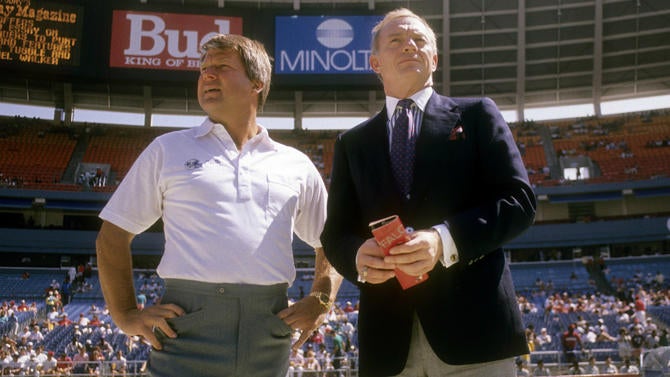
There was "backbiting, undermining and whispering" to the media about Jones' lack of football knowledge on Johnson's part, Jones maintains. "My girlfriend knows more about football," Johnson once said. And Jerry didn't like that one bit. When Jimmy refused to raise a champagne glass in a toast "to the Dallas Cowboys" at a dinner in 1994, Jerry decided he'd had enough, fired Jimmy, and hired his friend Barry Switzer as the new head coach.
To this day, Jones and Johnson still dispute who the mastermind behind the Walker trade was (even though most rational people side with Johnson). They're still trading barbs in the press, too. Jerry told ESPN's Don Van Natta in 2014 that the 1995 Super Bowl victory means "10-to-1 ... 1,000-to-1" times more to him than either 1992 or 1993, "Just simply because I guess I am still that damn frustrated with the way everything happened with Jimmy."
In the same story, Van Natta noted that on the 20th anniversary of the second Super Bowl victory, Johnson told Tim Cowlishaw of the Dallas Morning News, "What anniversary is this one? They're always having some kind of anniversaries down there. I guess because they don't go to Super Bowls anymore."
Jones wound up being correct that pretty much anybody could coach that particular Cowboys team to a Super Bowl. Switzer did it two years later, after all. But 20 seasons have gone by since then, and the Cowboys have all of three playoff wins in that time. They've cycled through Switzer, Chan Gailey, Dave Campo, Bill Parcells, Wade Phillips, and Jason Garrett at head coach. They have been the very definition of mediocre, compiling a record of 162-158 since that third Super Bowl victory.
All the money and all the star power and all the effort and Jerry still has not been able to recapture the magic, 20 years on. The Cowboys finally are beginning to build through the draft again, but that strategy has only taken hold in recent years as Jerry's son Stephen and top personnel man Will McClay have taken on more power. Jerry had tried and tried and tried to buy his way to another Super Bowl for years before ceding some control over the last few seasons. He was unsuccessful.
The Ugly
Jerry Jones fires Tom Landry
From 1960 through 1988, the Cowboys had one coach: the legendary Tom Landry. Only two teams -- the Raiders and Dolphins -- won a greater percentage of their games during that time. No team outscored its opponents by more than the 1,739 points the Cowboys did theirs in those 29 years, and it wasn't even close. The Raiders were almost 400 points behind.
During the 20-year stretch from 1966 to 1985, the difference between the Cowboys and the rest of the league was even starker. Dallas made the playoffs in all but two of those seasons, and even in those years, they finished with an above .500 record. They won 12 of 20 division titles, along with two Super Bowls. They were an incredible 208-79-2, and they outscored their opponents by 2,261 points. The Raiders were the next closest team at 1,749 points.
From 1986 through 1988, though, the Cowboys struggled due to an old, slow roster. They went 7-9, 7-8, and 3-13. In 1987 and 1988, the Cowboys were outscored by their opponents for the first time since 1964. And so when Jones bought the team in early 1989, his first move was to fire the third-winningest coach in NFL history and install his former roommate as the new top man in the organization.
The move was so shocking and poorly-received that then-commissioner Pete Rozelle compared it to Vince Lombardi's death. Jerry said he knew he would forever be known as "the man who fired Tom Landry," but that he wouldn't have bought the team unless he knew he could hire Jimmy.
(Jerry has obviously since become known as far more than just the man who fired Landry, for whatever it's worth. He has arguably been the most influential owner in league history due to his skill as a marketer, salesman, and power-broker. It's entirely possible he has made more money for the NFL than any other individual person.)
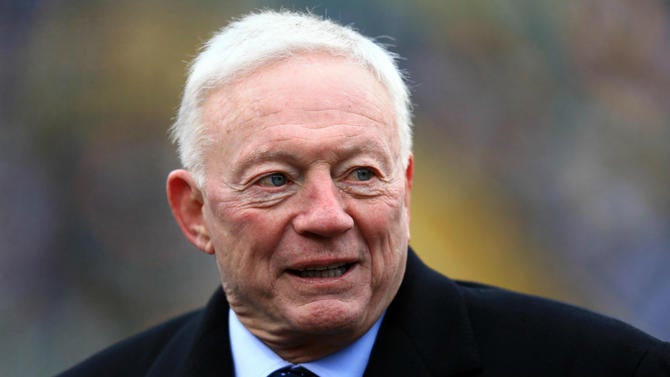
Landry was so disgusted by Jones' treatment of him and his family (including Jones allegedly taking away the family's suite at Texas Stadium and barring Landry's son from purchasing season tickets) that he died a Giants fan, according to a biography published 13 years after he passed.
Jones said in 2014 that he regretted handling the firing the way he did. "If I had a chance to do it over again I would've waited a year and just got my feet on the ground a little bit more and probably just gone with the staff that we had and then later made the ultimate change that I made," he said, per ESPN.com.
The Bizarre
The White House
It's difficult to describe exactly what the "White House" was without lapsing into descriptions that are extremely NSFW, but we'll try. Down the road from the Cowboys' practice facility, there was a house. The Cowboys -- well, a bunch of them -- partied there. They used the house primarily to do drugs (mostly cocaine) and sleep with women, some of whom were prostitutes. Rumor has it Irvin secretly recorded the proceedings at the house.
Pro Bowl offensive lineman Nate Newton once said of the White House, "We've got a little place over here where we're running some whores in and out, trying to be responsible, and we're criticized for that, too."
He later clarified that he didn't mean the women were literally whores; that's just how he referred to women. "Well, you know, when I meant the word 'whores,' I was just talking about females," Newton said. "You don't have to go out and buy no women. I mean, so I don't want people to think that I was saying prostitutes or nothing like that. Just women that got together and had fun with us."
It was the White House that got much of the attention, but that wasn't the only place the Cowboys were engaging in questionable (at best) activities. Michael Irvin was arrested in a motel room with cocaine, marijuana, and two strippers that were allegedly using the room for prostitution activities. At the trial, it came out that a policeman had been hired to kill Irvin after Irvin allegedly threatened the policeman's wife.
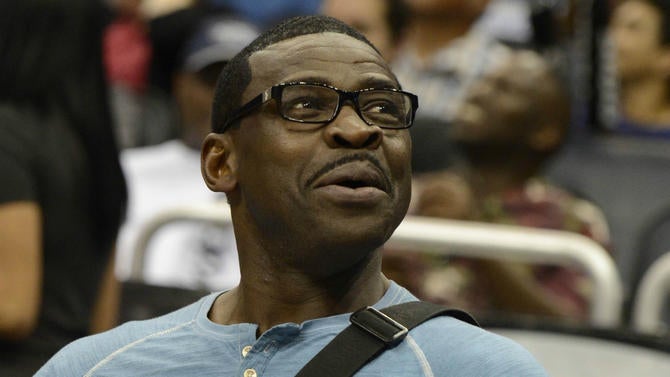
And that wasn't nearly the end of the craziness with this team. There was Charles Haley's endless locker room antics. There was the scissor fight in the locker room between Irvin and Everett McIver, which ended with blood shooting out of McIver's neck. (The fight was over who would get their hair cut first, of all things.) He was reportedly offer six figures to keep the incident quiet, and it was referred to in the press as "horseplay."
Multiple players plead guilty to drunk driving. (Offensive lineman Erik Williams nearly died in a drunk driving accident.) Others were suspended for drugs. Others were alleged to have sexually assaulted strippers.
Jeff Pearlman, who wrote the book Boys Will Be Boys, about the 1990s Cowboys, implied in an interview that at the height of its popularity, nearly half the team was using the White House for some sort of extracurricular activities. In the end, it was the off-field exploits, as much as the salary cap or the ouster of Jimmy Johnson, that led to the long, slow fall from grace of America's Team.
* * *
More Good, Bad, Ugly and the Bizarre
Where's your favorite NFL team? Check the schedule below
AFC East
- June 13: New England Patriots
- 14: Miami Dolphins
- 15: New York Jets
- 16: Buffalo Bills
NFC East
- June 17: Dallas Cowboys
- 20: New York Giants
- 21: Philadelphia Eagles
- 22: Washington Redskins
AFC West
- June 23: Denver Broncos
- 24: Oakland Raiders
- 27: Kansas City Chiefs
- 28: San Diego Chargers
NFC North
- June 29: Chicago Bears
- 30: Detroit Lions
- July 1: Green Bay Packers
- 4: Minnesota Vikings
AFC South
- July 5: Houston Texans
- 6: Tennessee Titans
- 7: Jacksonville Jaguars
- 8: Indianapolis Colts
NFC South
- July 11: Carolina Panthers
- 12: Tampa Bay Buccaneers
- 13: Atlanta Falcons
- 14: New Orleans Saints
AFC North
- July 15: Pittsburgh Steelers
- 18: Baltimore Ravens
- 19: Cincinnati Bengals
- 20: Cleveland Browns
NFC West
- July 21: Arizona Cardinals
- 22: Los Angeles Rams
- 25: Seattle Seahawks
- 26: San Francisco 49ers










